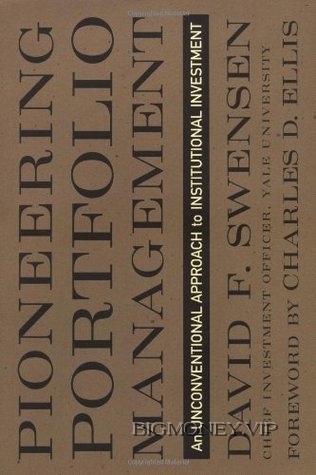Pioneering Portfolio Management: An Unconventional Approach to Institutional Investment by David F. Swensen

1
Introduction
When I wrote the introduction to the first edition of Pioneering Portfolio
Management in early 1999, Yale’s pathbreaking investment strategy had
produced excellent results, both in absolute and relative terms, but had not
yet been tested by adverse market conditions. In fact, Yale’s return for the
ten years ending June 30, 1998 amounted to 15.5 percent per annum, more
than three full percentage points short of the S&P 500’s 18.6 percent result.
The endowment’s deficit relative to the then-highest-performing asset class
of domestic equity caused naysayers to question the wisdom of undertaking
the difficult task of creating a well-diversified equity-oriented portfolio.
The years following the first edition’s publication proved the worth of
Yale’s innovative asset allocation. The continuation of the bull market in
1999 and early 2000 produced wonderful results for Yale, culminating in a
41.0 percent return for the year ending June 30, 2000, a result that trounced
the average endowment return of 13.0 percent. Yet, the real test of Yale’s
approach took place in 2001 and 2002 as the Internet bubble burst and
marketable equities collapsed. Yale posted positive returns of 9.2 percent in
2001 and 0.7 percent in 2002, even as the average endowment reported
deficits of 3.6 percent and 6.0 percent, respectively. In short, equity
orientation continued to drive Yale’s strong results, while diversification
kicked in to preserve the university’s assets.
From a market perspective, the vantage point of early 2008 differs
dramatically from that of early 1999. For the ten years ending June 30,
2007, Yale’s 17.8 percent return emphatically exceeded the S&P 500’s 7.1
percent. Twenty-year results tell a similar tale with Yale’s 15.6 percent
trumping the S&P’s 10.8 percent. In fact, Yale’s conspicuous success
attracted the attention of many investors, making the university’s strategy
seem less radical and more sensible, less pioneering and more mainstream.
In spite of widespread imitation of Yale’s portfolio management
philosophy, the university posted stunning returns relative to peers. For the
year ended June 30, 2007, Yale reported a 28.0 percent return, which
exceeded the results of all of the educational institutions that participated in
the 2007 Cambridge Associates Annual Analysis of College and University
Pool Returns. More significantly, Yale’s results led the pack for five-, ten-,
and twenty-year periods. The university’s pioneering portfolio management
works in theory and in practice.
The most important measure of endowment management success
concerns the endowment’s ability to support Yale’s educational mission.
When I arrived at Yale in 1985, the endowment contributed $45 million to
the university’s budget, representing a century-low 10 percent of revenues.
For Yale’s 2009 fiscal year, in large part as a result of extraordinary
investment returns, the endowment will transfer to the budget
approximately $1,150 million, representing about 45 percent of revenues.
High quality investment management makes a difference!
Institutions versus Individuals
When I wrote my second book, Unconventional Success, I characterized its
message as “a sensible investment framework for individuals,” in contrast
to the institutional focus of Pioneering Portfolio Management. I erred in
describing my target audiences. In fact, I have come to believe that the most
important distinction in the investment world does not separate individuals
and institutions; the most important distinction divides those investors with
the ability to make high quality active management decisions from those
investors without active management expertise. Few institutions and even
fewer individuals exhibit the ability and commit the resources to produce
risk-adjusted excess returns.
The correct strategies for investors with active management expertise
fall on the opposite end of the spectrum from the appropriate approaches for
investors without active management abilities. Aside from the obvious fact
that skilled active managers face the opportunity to generate market-beating
returns in the traditional asset classes of domestic and foreign equity, skilled
active managers enjoy the more important opportunity to create lower-risk,
higher-returning portfolios with the alternative asset classes of absolute




